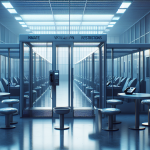San Quentin State Prison is one of the most infamous prisons in the US and the primary prison for inmates in the state of California. Inmates at San Quentin State Prison are eligible to receive visits from their loved ones with the appropriate paperwork.
To apply for visitation rights for a %%iterable%% San Quentin State Prison inmate, the applicant must submit a visitation request form to the prison administration’s background check department. This form needs to include all the necessary information about the visitor, including name, address, birthdate, and any other required information. The visitor must also have a valid photo ID
In addition, visitors must be approved by an inmate’s security officer prior to visiting and visitors must not have a criminal record. When the visitor arrives for their visitation, they will need to present a valid photo ID, which will be verified by prison staff.
Finally, %%iterable%% State Prison requires visitors to register at the visitor Center upon arrival. This involves undergoing a pat-down search and registering all personal items prior to entering the prison. After registering, visitors will be issued a visitor card and assigned a seat in the visiting area. Visitors are not allowed to bring any items into the prison, with the exception of a few personal items such as a car key and a single wallet.
Visitation hours are generally held on Saturday, Sunday, and holidays from 8am to 3pm. It is important to note that visitor procedures and opening hours can change depending on the prison’s operational needs. For the most up-to-date information, visitors should contact San Quentin State Prison for more information.
San Quentin State Prison – Overview and Information
San Quentin State Prison, located in Marin County, California, is a maximum security, state-run facility for adult male inmates. This prison is the oldest in the state and the largest of the state’s 35 prisons. San Quentin is a hub of activity, with maximum, medium, minimum and general population units, as well as several specialized programs for inmates. Here, inmates are able to participate in an array of programs, such as the lifeskills program, a drug treatment program, faith-based programs (including faith-based substance addiction programs), and others. They offer support designed to help inmates reintegrate into the community after their release, including a Substance Abuse Fellowship Program, which assists those who have battled addiction in their pasts.
San Quentin’s security level is rated as “maximum,” meaning that there are additional restrictions in place beyond those found in other California prisons such as double fencing, additional patrols, and special response teams. Inmates residing in the more secure units are assigned custodial staff to ensure proper supervision and monitoring. There are also very few, if any, outside visitors allowed into the prison.
San Quentin also houses the California Death Row, where inmates who have been sentenced to the death penalty are incarcerated while they process their appeals. Those on Death Row may not participate in any of the reformative programs offered at San Quentin.
San Quentin works in partnership with Marin County and other community organizations in order to provide inmates with additional support in the form of volunteer services and programs that help prepare inmates for successful reintegration into society after their release. The work of these organizations and volunteers plays a key role in making San Quentin a safe place for the residents of the surrounding community.
San Quentin State Prison – Classes, Services, and Programs
San Quentin State Prison is one of the oldest and most infamous penitentiaries in the United States. Opened in July 1852, San Quentin has seen some of the nation’s first executions and has housed over 23,000 prisoners over the years. The prison’s maximum security section houses California’s nearly 7,000 death row inmates.
San Quentin State Prison offers a variety of classes and services to its inmates. These classes and services are designed to supplement inmate work assignments, provide evidence-based programs and treatments, and train inmates in a variety of job and self-improvement skills to assist them in their post-release transition.
San Quentin offers an academic program known as ‘Prison to Education’ which provides a range of coursework from English and math to life skills and parenting. There are a range of accredited college courses offered by the College of Marin as well as self-improvement classes, such as anger management, conflict resolution, and financial literacy. A variety of vocational programs including auto mechanics, welding, carpentry and HVAC (Heating, Ventilation, and Air Conditioning) are provided which can help inmates gain valuable job skills. There are also the Arts-in-Corrections and Music Programs which support creativity and self-expression through music and artistic endeavors.
San Quentin offers a variety of medical services, ranging from mental health counseling and substance abuse treatment to physical and dental care. Inmates are provided access to medical care from a variety of providers, including psychiatrists, psychologists, nurses and physicians. Other services include family visits and video visitation, political and religious programs, legal services and library services.
San Quentin State Prison works to ensure that its inmates are provided the opportunity to develop both personally and professionally while they are incarcerated. Through the variety of classes, services, and programs offered, San Quentin helps provide inmates the opportunity to lead a more fruitful and productive life upon their release.
Inmate visiting application in San Quentin State Prison
Visiting someone in San Quentin State Prison in California requires completing a Visiting Information Packet. This packet covers guidelines for visitation at San Quentin.
The Visiting Information Packet includes an inmate visiting application. The application requires detailed personal information including name, address, date of birth, physical description, and driver’s license number of each visitor.
Each visitor must agree to the following information on the application: a) all visitors must submit to search and inspection of possessions; b) drugs, alcohol, and weapons are prohibited and will not be allowed on prison grounds; c) visitors are not permitted to communicate to or interact with any other inmates not related to their visit; and d) visitors must comply with facility dress code.
Visitors should make sure to sign and date the visiting application as well as each page in the packet and have valid photo identification in order to be approved.
The completed Visiting Information packet should then be mailed to: San Quentin State Prison, Visiting Room Officer, San Quentin CA 94974.
Receiving a visiting application approval takes approximately 2-3 weeks.
Visitors must call the San Quentin Visiting Room in advance to make an appointment.
It is also possible to register online to become a visitor at San Quentin. To register online, visit the website https://www2.cdcr.ca.gov and click on “Visits and Communications.” Following the steps to complete the visiting application.
For more information, visitors may call the Visiting Room at (415) 454-1460.
San Quentin State Prison: Frequently Asked Questions and Answers
San Quentin State Prison is California’s oldest prison and home to some of the state’s most notorious inmates. It is located in Marin County and houses an average of 4,000 inmates. San Quentin is a high security prison and one of the most-visited sites in the state.
Here are answers to frequently asked questions about San Quentin State Prison:
Q. How old is San Quentin State Prison?
A. San Quentin opened in 1852 and is the oldest prison in California.
Q. What is the security level of San Quentin State Prison?
A. San Quentin is a high security prison and not suitable for low risk inmates.
Q. What type of inmates are held at San Quentin State Prison?
A. San Quentin is primarily a male facility and houses inmates convicted of felonies and serious misdemeanors.
Q. What is the visiting schedule for San Quentin State Prison?
A. Visiting hours are from 9:00 a.m. to 3:00 p.m. on Saturdays and Sundays. Inmates have two hours of visitation each day, and visitors must arrive at least 30 minutes prior to visitation.
Q. Does San Quentin State Prison offer educational or vocational programs?
A. Yes, San Quentin offers both academic and vocational classes in various fields. Courses range from basic education classes to college level classes and many inmates have earned certificates or degrees.
Q. Does San Quentin State Prison offer substance abuse programs?
A. Yes, San Quentin State Prison offers substance abuse programs such as alcohol and drug counseling, 12 step programs, and educational sessions.
Q. Are there any special restrictions for San Quentin visitors?
A. Yes, visitors must be on the inmate’s approved visitor list and must have valid photo identification. Weapons, contraband, and other prohibited items are not permitted in the visitation area.
Q. Is there an inmate store at San Quentin State Prison?
A. Yes, there is a commissary where inmates can purchase snacks, hygiene items, stamps, stationary, and other items with funds from their own accounts.






